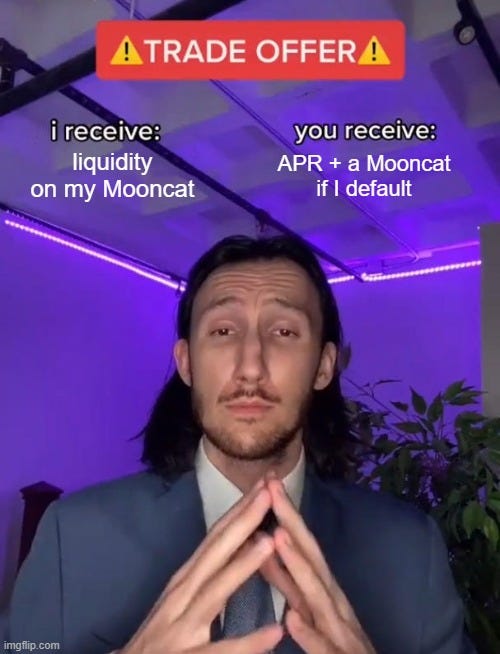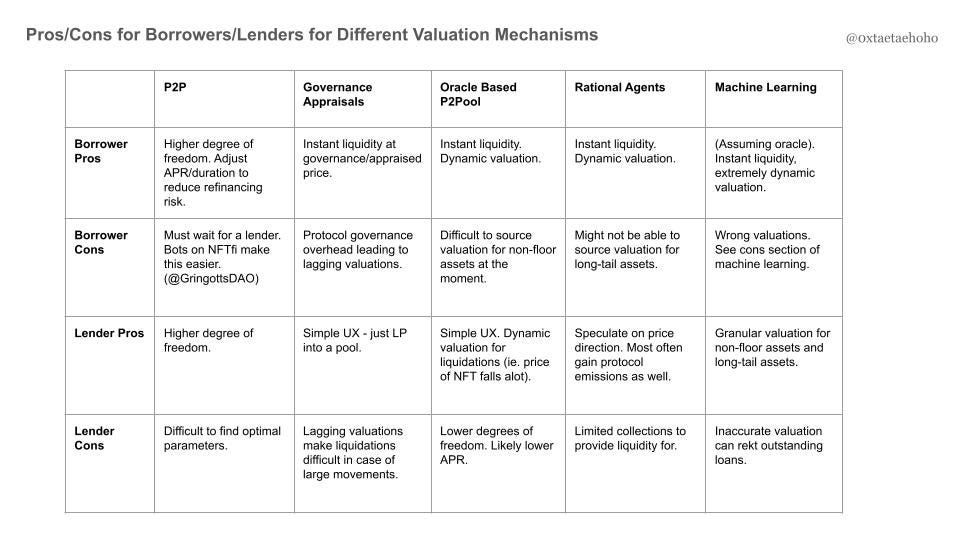Valuing NFTs as Collateral - Overview, Landscape, Pros/Cons
How NFT collateralized loan protocols establish collateral valuation
Some of my colleagues previously detailed the emerging protocols in the space of NFT finance and outlined methods of receiving liquidity for your NFTs using some of those protocols.
Today, I wanted to focus on one area of NFT financialization that I feel is the most obvious use case at the moment- receiving liquidity on your NFTs via NFT collateralized loans - and introduce how protocols in the space value the NFT collateral and the pros and cons of each method.
Why Bother in the First Place?
I have a valuable NFT. I don’t want to sell it, but I would like to receive liquidity on its value. One thing I can do is get someone to write me a loan collateralized by the value of the NFT. Now I get ETH to play my defi games and I keep my Mooncat.
A vital step within this process is valuing the collateral. A lender will only provide liquidity in so far as they are able to adequately secure their capital and get fairly compensated for the risk that they’re taking - your default for instance.
The lender can thus either
Establish that the borrower is trustworthy - which is hard in permissionless, anonymous environments
Or have assurance that the value of the collateral will be enough to preserve their capital in the case of default.
And thus for platforms that connect buyers and sellers of NFT liquidity, establishing a sound method of valuation is the most important thing.
NFT Collateralized Lending Landscape
Today protocols operating in the space use 5 main vectors to determine valuation.
P2P
Pioneered by NFTfi, the p2p model puts the onus of valuation on the borrowers and lenders. The platform acts as a marketplace where these actors can meet, negotiate terms and execute loans. A quick overview:
Alice, who wants liquidity on her Mooncat puts it up as collateral, signaling that she wants a loan.
Bob, who wants yield on his Eth, submits an off-chain loan offer, detailing principal, duration, and APR.
If Alice receives an offer she likes, she moves the loan on-chain. Her NFT is now locked and the ETH is transferred to her EOA.
Among all the valuation mechanisms, relying on p2p markets gives the most degrees of freedom to participants. Borrowers and lenders can dynamically negotiate multiple variables to best match their individual risk appetites and situational factors. For instance, a borrower that wants to execute a 15-day long defi strategy might want a 15-day duration loan to minimize refinancing risk. In protocols that simplify UX by not offering as many degrees of freedom (fixing APR, term length) traders cannot execute such strategies.
Protocols that alter and build on this model differ largely in the number of choices they offer market participants.
For instance on Sharkyfi, loans are all fixed term, and APR is decided based on a utilization curve. Lenders only get to decide the loan size. On the borrower's side, they’re automatically able to see the largest loan size offer at the top of an order book of loans, whose APR and term length are all uniform.
Arcade, on the other hand, requires that the borrower specify the loan terms, which the lender then fills.
P2P Pros
Highly customizable. This also makes it possible to negotiate special deals (ie - borrower and lender know each other and thus have more favorable terms, borrower and lender have term preferences and are willing to clear at non-market terms…etc).
P2P Cons
Figuring out optimal parameters can be difficult and resource-intensive.
Borrowers don’t get instant liquidity
No dynamic valuation adjustment, LTV based liquidations
2. Governance / Appraisals
On JPEG’d users can mint a stablecoin collateralized by NFT deposits (similar to how Maker mints DAI). At launch, the protocol values Alien Punks at 4000ETH and Ape Punks at 2000ETH, and all others at the punk floor. According to the protocol medium: “governance can change these values at a later date”.
Taker Protocol similarly establishes the value of NFTs through governance, but rather than governors of the protocol, valuation is established via consensus among expert appraisers.
A CuratorDAO is created consisting of “well-known individuals and projects within each NFT category”
The DAO provides a valuation at which all borrowers can take loans out at (with an LTV buffer).
The DAO underwrites the loans themselves with their own capital and assumes the risk of the loan and default and is thus incentivized to provide accurate valuations. (There is significant overlap between this design and p2p/rational actors).
Governance/Appraisals Pros
Borrowers get instant liquidity
Valuation is determined by human consensus and verified over a lengthy vote process, and therefore not prone to manipulative price attacks.
Governance/Appraisals Cons
Governance can be slow to adjust
Hard to dynamically adjust valuation
Possibility of a governance attack through on-chain vote-buying
3. Oracles and P2Pool that uses Oracles
Oracles are able to achieve real-time dynamic pricing of NFTs based on an external price feed. Protocols that use oracle data feeds largely differ in
The source of the data
How they aggregate the sourced data.
Among the protocols we studied, two sources were the most widely used.
Opensea API - this information is brought on-chain via a Chainlink oracle.
This data feed is then aggregated, most often in the form of a TWAP. Then data from different sources are combined into a final price in a weighted average.
For instance, Drops DAO uses three data sources, the Drops NFT Floor TWAP, NFTX Floor Price TWAP, and a Chainlink NFT oracle which they then aggregate into a weighted average floor price for a collection. A borrower then takes a loan out at an LTV % of this dynamically adjusted valuation.


Pine Protocol uses min(7-day average transaction price, collection floor price) obtained from the Opensea API. Generally speaking, TWAPs were the most common data aggregation method we observed among NFT collateral lending protocols.
Oracles Pro
Dynamic valuation
Borrowers get instant liquidity
Oracles Con
Can be manipulated - the more illiquid a market the easier to manipulate. A malicious actor could continuously list an NFT at a low price and buy the NFT themselves causing liquidations for that particular collection. This only works if the NFT in question is highly illiquid with very few arbitrage bots. It is thus important to maintain a listing requirement (either via governance or automatic).
4. Rational Agents
Profit maximizing agents are incentivized to determine the correct valuation of NFTs. Most often this works by establishing skin in the game among valuation providers where agents lose on a default or lower-than-valuation market sale while they gain otherwise. We’ll explore two different methods of how we’ve seen this done but there are many different alternatives.
Abacus Spot
Abacus uses a method of valuation they call “optimistic proof of stake”. Here’s a quick outline of how it works but if you want specifics, check out their whitepaper.
Alice is a profit-maximizing trader. She sees a pool open for a rare punk and decides to lock ETH into the pool (we’ll explain why later). The longer she locks her ETH for, the more protocol token emissions ($ABC) she gets.
She was fast so she got the first “ticket” - the first 0-1ETH in the pool was hers.
Bob and friends are also locking ETH into the pool.
NFT owner Charlie sees 20 ETH in the pool, locked by Alice and Bob, but Charlie thinks his NFT is worth less than that.
Charlie immediately “closes” the pool (only Charlie can do this because he owns the NFT) which transfers all the ETH in the pool to Charlie, and puts the NFT up for a 48hr auction.
If the NFT sells for more than 20 ETH, profits are transferred to Alice and Bob and friends. Those who lock later get proportionally more of the profits. This is because…
If the NFT sells for less than 20 ETH, then profits are dispersed First-in-first-out (FIFO) style. Alice who locked in at the 0-1 ETH ticket will get 1ETH back, but Bob who locked at 19-20 ETH doesn’t get anything.
Hence in step 6, Bob received a larger payout for taking a larger risk.
There are additional intricacies that happen around expiry, the buying and selling of tickets, but in general, traders are motivated to lock enough ETH such that
Potential profit from sale + token emissions = Opportunity cost of capital (locked ETH)
Once Abacus establishes a valuation, other protocols can provide loans at this valuation. Gradient is such an example.
Pilgrim


And thus the protocol uses profit-maximizing rational actors to establish a valuation for the NFT, in this case, the total liquidity within the pool.
Rational Agent Pros
Establish a forward-looking valuation. This is also true for P2P and governance-led valuations while oracles are backward-looking.
Rational Agent Cons
Protocols have to attract traders to the platform
At the moment, these protocols establish valuations for individual NFTs which is hard to scale
5. Machine Learning
Valuation protocols use machine learning, taking in past transactions and traits as inputs to predict valuations. NFTBank and Banksea Finance are prime examples.
To get a better sense of NFTbank’s algorithm check out How to value items in NFT projects? — Part 1. Already as of Nov 2021, their models were accurate to a single-digit median absolute percentage error for Axie assets.
Performance of NFTBank’s model as of Nov, 2021.
NFTBank has announced a partnership with Chainlink to bring their prediction prices on-chain, so protocols that require real-time NFT valuation can use their data feeds.
Banksea Finance, in its original grant proposal, expressed the desire to incorporate “NFT creator information, attributes, historical transactions, media coverage, community status, popularity, and other information for evaluation of NFT value trend and NFT public opinion trend” to determine the price.
Machine Learning Pros
Real-time dynamic data, updated every transaction that happens within the collection
Machine Learning Cons
Larger margin of errors of NFTs within the same trait group as an outlier sale
Can fail to predict systemic market movements (ie. Meta changes within gaming NFTs, market condition changes for general NFTs). Sophisticated traders/appraisers might be able to catch this.
Hard time responding to “game-changers”.
Backward-looking for now.
Mapping Pros and Cons for Borrowers and Lenders to Valuation Methods
Conclusion
NFT finance season is coming. Soon sourcing liquidity for NFTs will be as seamless and often used as defi CDPs.
If you enjoyed this article and want to read more like this, give it a like, retweet, and follow me on Twitter @0xtaetaehoho. If you’re building in this space, I’d love to chat - my DMs are open.
Special thanks to @mikey_0x and @KoschigRobert for reviewing this.
Views are my own and do not represent those of my employer 1kx.










Embedding transaction psychology in the product is conducive to giving full play to the value of everyone's behavior under the web3 architecture. The vast majority of current products are mechanical.